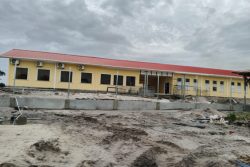A new National Strategic Plan (NSP) to address HIV was launched yesterday and Health Minister Dr Frank Anthony announced that a more comprehensive Pre-exposure prophylaxis (PrEP) programme would be rolled out this year.
The NSP is expected to keep Guyana in line with global efforts focused on ending the HIV/AIDS epidemic by 2030 and is also expected to build and improve the country’s response to the epidemic.
Anthony, during the virtual launch of the new NSP, stated that during this year, the public can expect to see the rollout of a more comprehensive PrEP programme.
PrEP is an HIV prevention approach where HIV-negative individuals use anti-HIV medication to reduce their risk of becoming infected if they are exposed to the virus. It can stop HIV from taking hold and spreading throughout the body.
“As you know in the past we have introduced PrEP for serodiscordant couples (a relationship where one partner is infected with HIV and the other isn’t) and now we want it take that a step further so that anybody who is at risk, they would be able to access PrEP,” he said.
Anthony went on to say that with the new plan, the ministry would also like to look at the possibility of self-testing, which is a relatively new initiative that has been advocated for around the world and has even been implemented in some countries with relatively good success.
Anthony stated that the new NSP bridges what the country has done in the past with the various achievements that have been made in the response to the epidemic. “While we aspire to end AIDS by 2030 and get to that end point, there are many steps that we have to take along the way,” he added.
Guyana, he said, has done remarkable work in achieving some international goals set, including ensuring 90% of all people living with HIV will know their HIV status as part of the global plan to end HIV/AIDS by 2030. The global targets also include getting 90% of all people with diagnosed HIV infection to receive sustained antiretroviral therapy by 2020 and 90% of all people receiving antiretroviral therapy to have viral suppression by that same time.
According to Anthony, Guyana has been able to have some significant achievements with this but still has lots of work to do. “We were able to achieve the first 90 because we are now currently at 94% of persons who are HIV positive and have been tested so they know their status. But we’re a little still off and that is for the persons who have been tested and are on treatment. We are at 73% and for those who are on treatment and are virally suppressed we are at 75%, which means that we still have a lot of work to be done,” he noted, while adding that work is needed to address and fix existing problems and further use new methodologies to achieve the other targets for 2025.
Road map
Meanwhile, Ministry of Health Consultant Dereck Springer, who dealt with the NSP document, stated that the NSP, dubbed “HIVISION 2025”, provides a roadmap for the country’s response to HIV over the next five years and will serve as a tool to mobilise resources required for sustaining the HIV response in the current environment where there has been rapidly declining external funding.
“HIVISION 2025 provides a clear vision; it articulates the goals, the objectives, strategies, priorities and key actions for achieving the… results and advancing the country’s progress towards ending AIDS as a public health threat,” Springer said during the virtual launch.
He further added that the NSP was informed by a number of evaluations and international recommendations, which included the UNAIDS 90-90-90 target, the PAHO plan of action under prevention and control of STIs and the Caribbean Regional Strategic Framework on HIV and AIDS.
When speaking on the current response to the epidemic, the consultant stated that, “There is strong political commitment and an enabling environment to accelerate the national response towards ending AIDS and eliminating mother-to-child transmission. All the necessary structures, policies and guidelines are in place but may need further strengthening or urgent action to fill human resource gaps.”
He mentioned that the country has achieved a number of milestones in various areas, which included achieving the first 90 of the UNAIDS 90-90-90 target and the initiation of services which forged public-private partnerships around prevention, treatment and care. He added that Guyana was also able to efficiently manage the transitioning and sustainability and domestic financing efforts following the fast decline of donor resources.
However, after praising the achievements, he stated that the response still faced numerous challenges that should be resolved immediately. Some of those he identified included the high level of stigma and discrimination which resulted in gender-based violence and death, weak paper-based monitoring systems and frequent stock outs of drugs and testing supplies. “STIs continue to increase and the data revealed that more women than men are accessing services and being diagnosed,” Springer said.
The recommendations made in the NSP are expected to address all these issues and are also expected to improve Guyana’s overall response to the epidemic.








